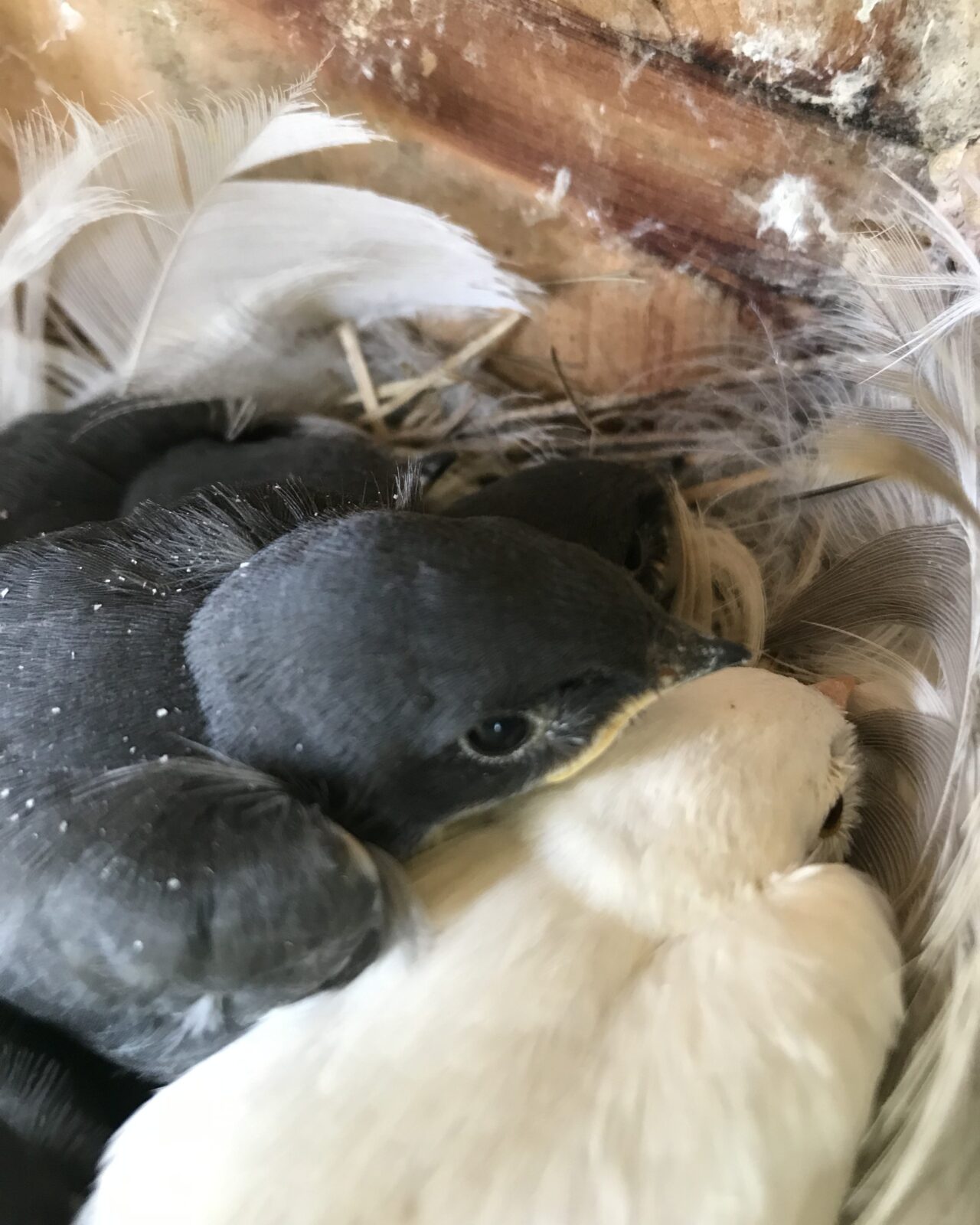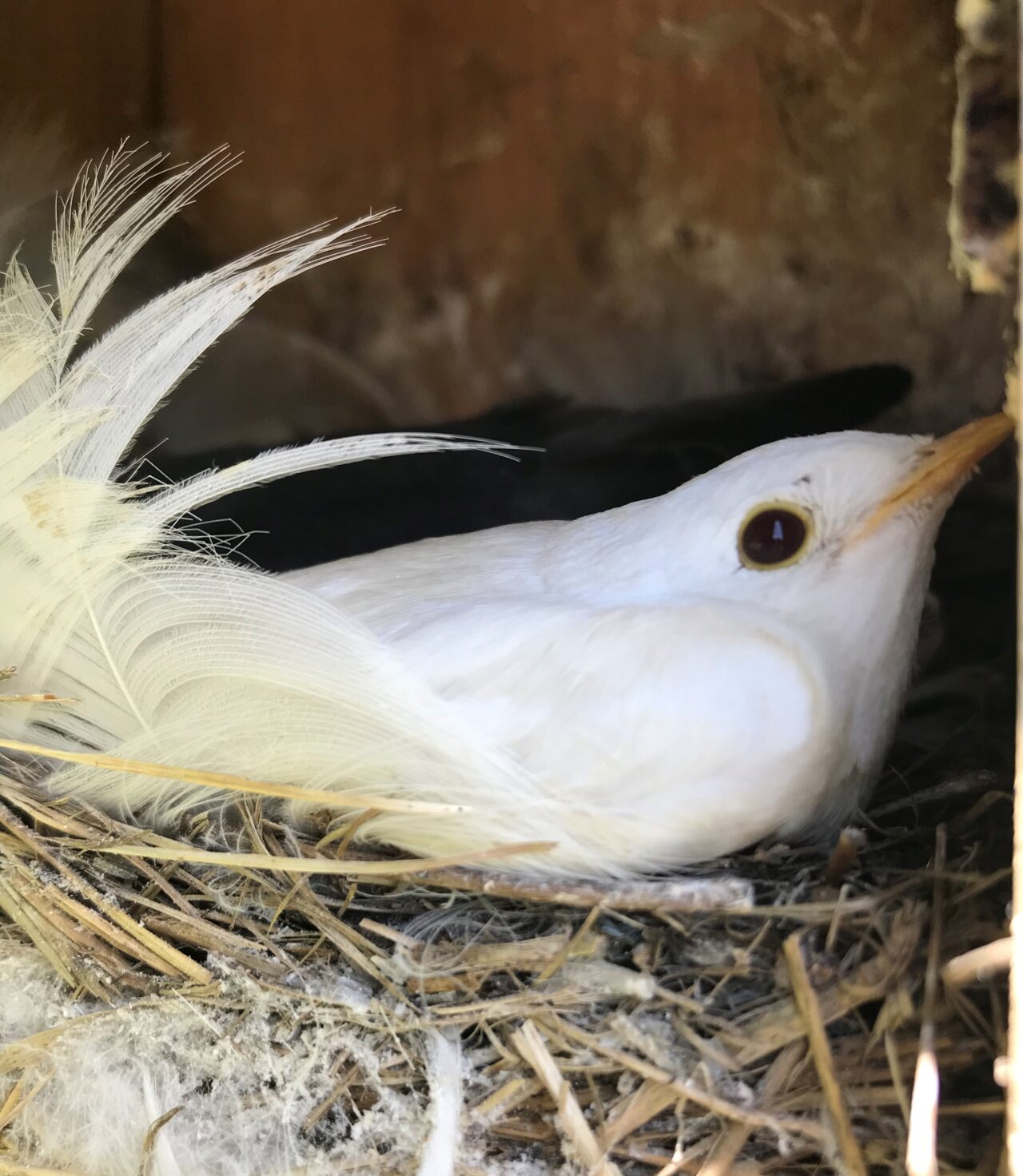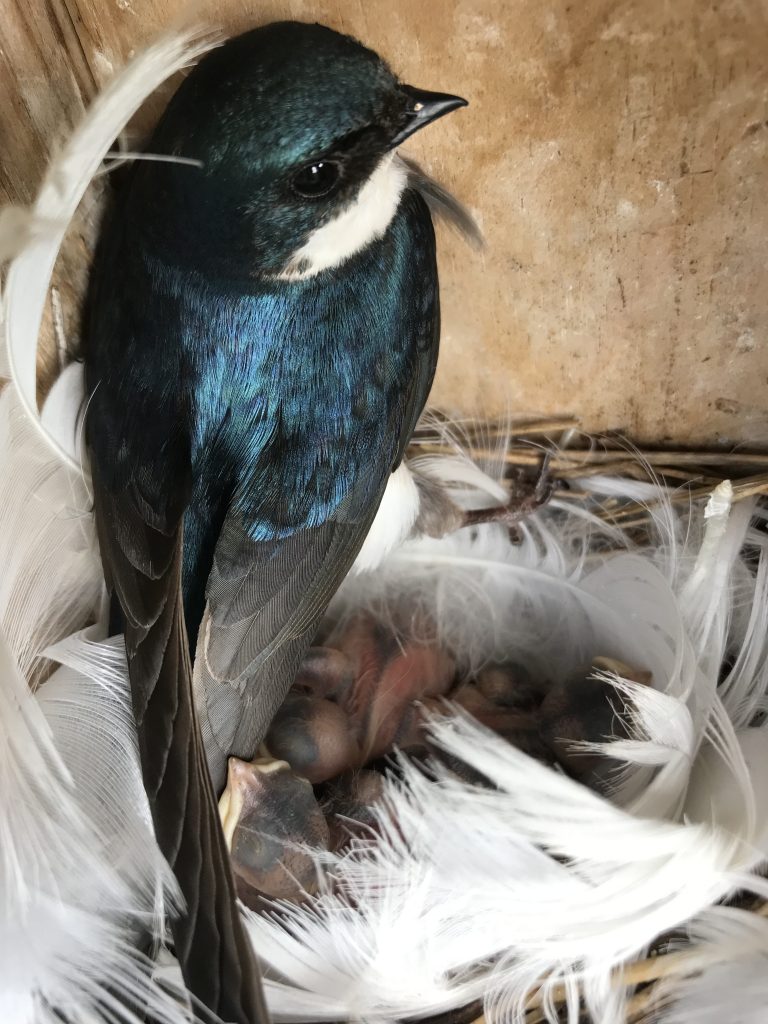NestWatcher Finds Rare Albino Nestling
June 17, 2019
An Albino Tree Swallow In The Nest
Look closely! This all-white Tree Swallow nestling blends in with its feathery nest.
By Robyn Bailey, NestWatch Project Leader.
On June 12, 2019, NestWatcher Edie Wieder reported an albino nestling Tree Swallow in a nest box in Needham, Massachusetts. Edie monitors 20 bluebird nest boxes as a volunteer with the Trustees of the Reservation in Massachusetts, and this is her second year participating. Albinism is a genetic mutation that prevents the body from producing melanin. Tree Swallow nestlings typically have sooty gray upper parts, like the sibling pictured below, and that gray coloration is due to melanin. Notice also how the bill is pinkish in this first photo of the rare youngster.
Unexpected Finding
Edie reports that both parents had normal coloration, as did all four of its siblings. The finding was especially surprising because this particular nest was one in which the female preferred to stay on the nest during nest checks, even after the young had hatched. Edie wasn’t sure what she would find when she checked the nest on June 12th, but she certainly wasn’t expecting to find a snow-white nestling. At first, she was confused, thinking another bird might have laid an egg in this nest…except she knew that there aren’t any pure white cavity-nesting species in her area. She snapped a photo so she could leave the birds in peace and examine the evidence later. It wasn’t until later that she realized how rare her sighting was.

A Vision In White
Notice how the bill has darkened to yellow in this photo, a sign that not all pigments are absent.
Other Types of Color
Not all color is derived from pigment. As adults, Tree Swallows get their iridescent blue-green plumage from the structure of their feathers, which scatter light. The feathers have a base of melanin, so if you were to destroy the structure of the feather, you would see only gray. This albino nestling will not obtain the iridescent teal plumage as an adult because there is no base of melanin, which plays a role in the scattering of light.
By comparing these two photos, we can see that the bill changes from pink to yellow; however, this is no trick of the light! Albinism is a lack of melanin, which is made by the body; however, other pigments may still be present in the body. Carotenoids are the class of pigments responsible for oranges and yellows, and albinistic birds can have them in spades (check out this yellow albino American Goldfinch). Unlike melanin, carotenoids are obtained from the diet. From the change in bill color, we can deduce that by the time the second photo was taken, the little nestling had obtained enough carotenoids through its diet to change the bill color to yellow. Therefore, the bills of typical Tree Swallow nestlings must contain both melanin and carotenoids, with the black hues masking the underlying yellow. In the albinistic nestling, there is nothing to mask the yellow color.
The Eyes Have It

Female Tree Swallow On The Nest
The blue-green color in adult plumage is a result of feather structure, rather than pigment.
Although difficult to see in the photos, Edie reports that the eye was red rather than the typical dark brown. The eye, containing no other pigments, appears as red due to the underlying blood vessels. Pink or red eyes are a good indicator that a bird is truly an albino, rather than a species that just happens to be all white (like the White Tern).
Once In A Lifetime
Albinism is rare, with estimates ranging from 0.05% to 0.1% frequency in birds. A sighting this unique might come only once in a NestWatcher’s lifetime, so keep your eyes out for unusual birds. Thanks to Edie’s observations, we can all share in the joy of discovering something unexpected.

29 comments on “NestWatcher Finds Rare Albino Nestling”
Although the nestling does appear to have pure white feathers, its dark eyes indicate that it is not an albino. Still, an amazing observation!
Hi Manuel, Edie told us it’s hard to see in the photos, but the eyes are indeed red.
This swallow does not appear to be an albino. Its eyes are normally pigmented. Rather, it is a leucistic tree swallow, which is probably even rarer than if it were albino.
Hi Audrey, Edie told us it’s hard to see in the photos, but the eyes are indeed red.
I Think That’s Truly Amazing & Edie Was Extremely Lucky To See This Albino Tree Swallow, WOW!! Thanks For Sharing With Us, As Really Love Seeing This Cool Bird!!
I was wondering what kind of feathers the mother swallow used to line her nest. They appear to be white feathers. Any ideas as to what bird they came from?
Hi Martha, Most nest material is collected near the water’s edge, or on the ground, usually within 30m of the nesting site. Tree Swallows usually choose contour feathers from other species including waterfowl, gulls, and domestic fowl to line their nests.
Just when you WANT that camera “red eye” effect, that’s when it’s not available! I swear that when viewing this bird with my own eyes, the eyes were markedly red. What went through my mind at that moment upon seeing the red eyes was “better close this door quickly because this bright sunlight must be hurting its eyes”, knowing that albino individuals are very sensitive to sunlight. Truly a once-in-a-lifetime experience.
Wow, Edie. You are a very lucky birdwatcher. Thank you for sharing this rare beauty in nature!
What an incredible find! Thank you so much, Edie, for sharing your experience, and getting such detail. Glad I opened this link and read this piece, great details, including why the nestling had dark eyes (which, of course it didn’t). I wouldn’t have thought about the light sensitivity. Going to go check my bluebird box now!
Won’t this albino be in more danger of being taken by hawks, owls or eagles? I’ve always read that an animal that is colored differently, especially an albino, can be readily singled out by predators.
I think you may have to add 2 more birds to your watchlist. Although not considered “feeder” birds. I have Rofous Sided Towhee and Mockingbirds that visit my feeders. I had a fellow bird lover tell me that a Mockingbird is the most aggressive at guarding her feeder. Things are changing I guess.
Seems like black eyed, more like Leucistic bird, but probably light effect.
Thanks for sharing the photos Edie. So cool!!!
Thank you for sharing these photos! Such a amazing experience! Keep up the good work nestwatchers!
in the early 80s, i lived where there were, it seemed, thousands of swallows — tree, barn, and martins — in southern wisconsin. there was an albino tree swallow flying with them, and perching shoulder to shoulder on the power lines. i could see it was a tree when it perched nearby, and i could see it flying with the others at a distance in front of nearby woods. i did take a couple snapshots, but all you can see is a white dot.
Thank you Edie! Nature is a magnificent thing!! <3
Maybe I’m lucky or they are not as rare as indicated. I have swallows nesting under my deck and I have seen two pure whites in the last several years. Could be the same swallow. I managed to capture a photo of one flying around the backyard. The interesting thing is that the other swallows seemed to harass the albino or luecistic white.
I have a friend that took a picture of an all Ruby Throat Hummingbird. I got to see the hummingbird once. She has 10 large feeder and hundred of hummers. It’s amazing. Love the article. Thanks for sharing
Thanks for posting these pictures! As someone stated above, Will this albino be singled out by predators because of its coloring?
thank-you for sharing your photo with us, like to see it flying keep us posted. again thank you.
cool!
I have been involved with a wildlife rehab facility in CA for 16 years. In 2012 a bird was brought to me. Imagine my surprise when I opened the box to reveal a full albino Acorn Woodpecker! She was deemed unreleasable because of her poor eyesight and “white flag” looks.
So, are albino birds at greater risk with predators? I’ve just started watching birds again. One bird I heard all the time in summer had a very long song sequence and didn’t repeat the same short riffs that made up its song. It always made me smile, sometimes giggle, with all the different sounds. I never did hear it repeat its self. This was in the driftless area of southern WI.. Does anyone know what this “mocking”like bird is/was?
Albino birds are indeed easier to see against dark backgrounds, but otherwise they generally do not have any disadvantages due to the albinism. As for the bird song you’re describing, it sounds like it might be a Winter Wren, which are known for their long, drawn-out songs. Take a listen here to see what you think (click on the first sound file below the video).
I posted a picture of a strange white headed robin in my neighborhood. Then noticed several robins with white patches, like a genetic thing. Strange.
Hi Christy, What you’re describing is likely a form of leucism. Check out this page from our sister project, Project FeederWatch, on coolor variations in birds.
This is so neat!! keep up the good work 🙂
Will this bird have a hard time attracting mates because of it is albino?